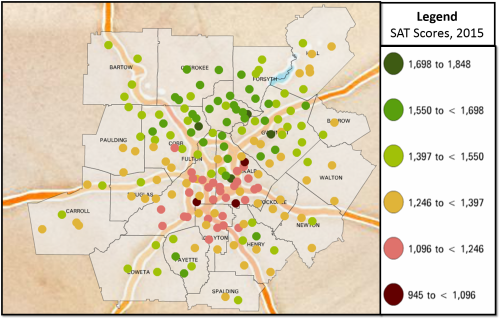The Georgia Department of Education (DOE) recently reported that high school students in the state achieved a 5-point increase in their SAT scores from 2014 to 2015. This improvement comes amidst a 7-point decline in the national average. Broken down by test components, Georgia test-takers achieved an average increase of two points from 488 to 490 on the reading portion, an increase of three points from 472 to 475 on the writing portion, while the math portion remained at 485. Overall, Georgia’s cumulative mean SAT score of 1450 is still below the national average of 1490. The increase, however, suggests a positive trend in the direction in which Georgia high schools are heading, albeit one that conceals persistent challenges.
Figure 2. Cumulative SAT Scores, 2015 (Atlanta Region)
Figure 2. Map of mean cumulative SAT scores for high schools in the 20-county Atlanta region showing intra-regional disparities. Created using Neighborhood Nexus (www.neighborhoodnexus.org) with data provided by the Georgia Department of Education.

Figure 1. Cumulative SAT Scores, 2015 (Georgia)
Figure 1. Mean cumulative SAT scores for high schools in Georgia in 2015 showing disparity between the north and south of the state. This map was created using Neighborhood Nexus (www.neighborhoodnexus.org) with data provided by the Georgia Department of Education.

To put SAT scores in context, the College Board produces what it calls “The SAT College and Career Readiness Benchmark,” which is 1550, the score at which a student has a 65 percent likelihood of getting a B- average or higher in her first year of college. In Figure 2 above, these schools are represented in the two darkest greens. Again, we see the spatial disparities in the Atlanta region. Most of the schools that would be classified as “college ready” are located in the northern parts of the region, which is, on the whole, wealthier than the southern portions of the region.
A closer examination reveals that the schools falling below the benchmark are have much higher proportions of students designated as economically disadvantaged (Chart 1, below). So while SAT score are improving in Georgia, and improving at a faster rate than other states, on average, we still need to mind the achievement gap.
Chart 1. Percent of Economically Disadvantaged Students by “College Readiness” Benchmark
Bar chart showing the median percentage of students designated economically disadvantaged in schools either above or below the College Board’s “SAT College and Career Readiness Benchmark” of 1550. Created using data from the Georgia Department of Education.


